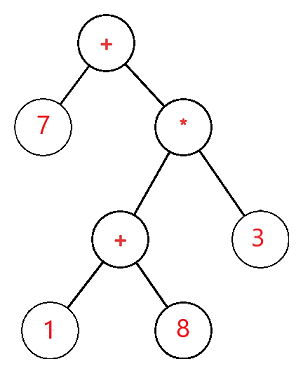Expression tree in data structureThe expression tree is a tree used to represent the various expressions. The tree data structure is used to represent the expressional statements. In this tree, the internal node always denotes the operators.
Expression trees play a very important role in representing the language-level code in the form of the data, which is mainly stored in the tree-like structure. It is also used in the memory representation of the lambda expression. Using the tree data structure, we can express the lambda expression more transparently and explicitly. It is first created to convert the code segment onto the data segment so that the expression can easily be evaluated. The expression tree is a binary tree in which each external or leaf node corresponds to the operand and each internal or parent node corresponds to the operators so for example expression tree for 7 + ((1+8)*3) would be: 
Let S be the expression tree If S is not null, then If S.value is an operand, then Return S.value x = solve(S.left) y = solve(S.right) Return calculate(x, y, S.value) Here in the above example, the expression tree used context-free grammar. We have some productions associated with some production rules in this grammar, mainly known as semantic rules. We can define the result-producing from the corresponding production rules using these semantic rules. Here we have used the value parameter, which will calculate the result and return it to the grammar's start symbol. S.left will calculate the left child of the node, and similarly, the right child of the node can be calculated using the S.right parameter. Use of Expression tree
Implementation of an Expression treeTo implement the expression tree and write its program, we will be required to use a stack data structure. As we know that the stack is based on the last in first out LIFO principle, the data element pushed recently into the stack has been popped out whenever required. For its implementation, the main two operations of the stack, push and pop, are used. Using the push operation, we will push the data element into the stack, and by using the pop operation, we will remove the data element from the stack. Main functions of the stack in the expression tree implementation:First of all, we will do scanning of the given expression into left to the right manner, then one by one check the identified character,
Implementation of Expression tree in C Programming languageThe output of the above program is: X + Y * Z / W Implementation of Expression tree in C++ Programming languageThe output of the above program is: X + Y * Z / W Implementation of Expression tree in Java Programming languageThe output of the above program is: X + Y * Z / W
Next TopicGarbage Collection in Data Structure
|
 For Videos Join Our Youtube Channel: Join Now
For Videos Join Our Youtube Channel: Join Now
Feedback
- Send your Feedback to [email protected]
Help Others, Please Share










